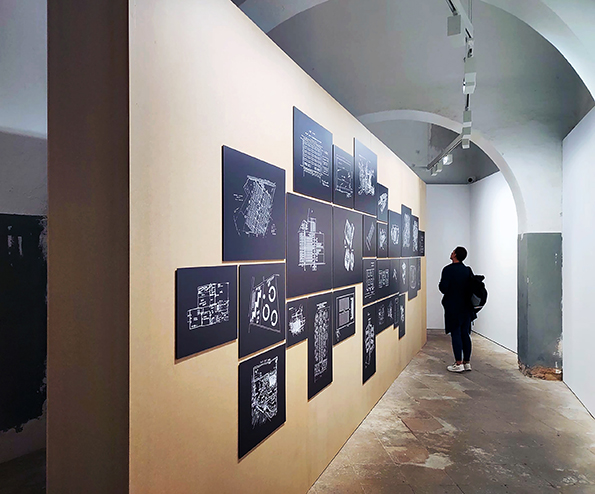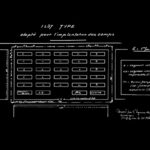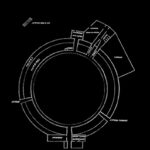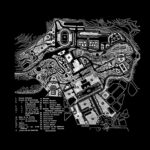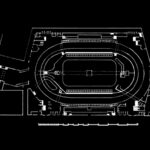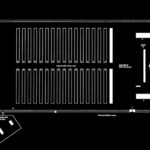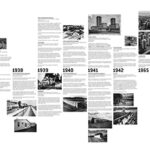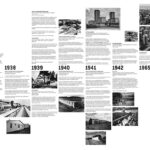2024
Series of 30 images of various sizes.
Ink print on 3mm Palboard
Total size: 227 X 724 cm.
Wallpaper
Ink print on paper
122 X 206 cm.
A project for Manifesta 15
A producction by M/A/C Mataró Art Contemporani
The Catalan artist Domènec’s A Century of European Architecture departs from the question: Was the concentration camp the defining architectural type of the 20th century? A product of modernity, the concentration camp is a fairly recent invention, emerging in the late 19th century. Throughout the 20th century, a terrific array of European political entities interned many diverse groups in concentration camps. The proliferation of such camps is inextricably linked with the organising principles of the nation-state, which have a tendency to produce a segment of the population that does not “fit”. Time and again in societies where these principles are strictly followed, those deemed “other” have been forcibly separated from the “healthy” social body.
With drawings, photographs, plans, models, sculptures and in-situ interventions, A Century of European Architecture interrogates the architectural dispositive of concentration spaces in Europe.
For Manifesta 15, Domènec has created an adapted version of the project that reflects upon the panoptic design of the Mataró Prison, acknowledging that the built environment is never neutral and that this venue’s original function must not be forgotten.
What is a camp? Some case studies.
1914
STOBS CAMP
Military training camp / concentration camp
Hawick, Great Britain
Stobs Camp is a military and internment camp on the outskirts of Hawick. In 1914, at the outbreak of World War I, Stobs Camp became a prisoner-of-war (POW) camp.
Only 3,100 of the 13,600 prisoners held in Great Britain on 22 September 1914 originated from the battlefields. Most of the remaining 10,500 were from Britain’s German civilian community and were interned “to safeguard the nation from internal spies”.
Stobs Camp was a civilian POW camp until the spring of 1915, after which it became a mixed camp with the addition of military prisoners. Eventually, the civilian POWs were transferred to Knockaloe on the Isle of Man, and from July 1916 until the end of the war, Stobs was a purely military POW camp.
1918
SUOMENLINNA
Military fortress/concentration camp/artist residence
Suomenlinna, Helsinki, Finland
At the end of the Finnish civil war in 1918, the victorious White Army and German troops were holding approximately 80,000 “red” prisoners; after summary executions and the release of women and children, 76,000 remained. All were interned in concentration camps; between 11,000 and 13,500 died of hunger and cold. The dead were buried in mass graves next to the camps. One of the camps that was set up – using former military barracks – was the prison camp on the island of Suomenlinna, opposite Helsinki. From 14 April 1918 to 14 March 1919, a total of 8,000 prisoners, members of the Red Guard and sympathisers of left-wing organisations, were interned in the camp. About ten of the prisoners died of starvation and disease.
Today, the island of Suomenlinna is a major tourist destination. One of the main houses used as a concentration camp is an artist’s residence.
1928
PALACE OF THE MISSIONS
Exhibition space for colonial artefacts / prison camp / immigrant internment centre
Barcelona, Catalonia, Spain
In the 19th century, with the industrial revolution, Barcelona became the economic engine of Spain. In a perfect symbiosis of public and private interests, the authorities and industrialists designed a series of events to promote Barcelona’s image internationally as a business city: the Universal Exhibition of 1888 and, in 1929, the International Exhibition.
The 1929 exhibition site was located on Montjuïc and represented the radical transformation of an important part of the mountain.
Just after the end of the Civil War, Franco’s dictatorship decided to use some of the sites and facilities of the 1929 International Exposition to intern immigrants. The Palacio de las Misiones was initially used as a prison where thousands of Republicans detained by the fascist regime were held. In the early 1950s, the Palace became an “indigent classification” centre used to detain and classify immigrants from all over Spain before returning them to their place of origin. Without having committed any crime, after spending an indeterminate amount of time in detention, some 15,000 people were deported in some 230 specially equipped trains.
1932
KOMSOMOLSK-NA-AMUR
Industrial city / concentration camp
Russia
Komsomolsk-na-amur is an industrial city in the Russian Far East. Founded in 1932, today it is home to oil refineries and a huge shipyard that builds military vessels. There are also 36 schools and two universities.
When it was founded, it was promoted as part of the grand project to build up Soviet industry at an accelerated pace. The plan was to build a large industrial city on a site close to Siberia’s immense natural resources. Legions of volunteers were recruited from the Communist Youth Union, the Komsomol. Hence the name Komsomolsk: the city of communist youth. Conditions were very harsh and within two years most of the volunteers had left. From then on, the regime relied more and more on sending prisoners, most of whom were political prisoners.
There were two peaks in the arrival of prisoners. The first was in 1936-37, after the so- called Moscow trials, when tens of thousands of workers who had made the revolution were falsely accused of supporting the counter-revolution. The second wave came in the aftermath of the Second World War, and had two components. On the one hand, Red Army soldiers who had been taken as prisoners of war by Germany and who, despite their sacrifices, were treated as potential enemies. The second component was the Japanese prisoners of war.
1937
PLASENCIA CONCENTRATION FIELD
Bullring / concentration camp / bullring
Plasencia, Spain
The Plasencia bullring was inaugurated in 1882.
During the Spanish Civil War, the square housed a Francoist concentration camp from July 1937 to November 1939. Some 800 Republican prisoners were interned there, in overcrowded conditions under the watchful eye of more than 100 armed men.
Since its re-inauguration, the bullring has always hosted two major bullfighting events a year. During the rest of the year, the bullring usually hosts other cultural events, such as concerts and music shows.
UNIVERSITY OF DEUSTO
Private university / barracks / hospital / concentration camp / private university
Bilbao, Basque Country, Spain
The University of Deusto was founded in 1886 by the Jesuits in the city of Bilbao.
At the beginning of the Civil War (1936), it became a barracks for the UGT union (Unión General de Trabajadores) militia and a hospital, and from 19 June 1937, with the fall of the city into the hands of the fascist troops, a concentration camp (June 1937-March 1940). The camp held some 5,000 prisoners, 188 of whom were executed.
In the same year, the university returned to its original function and to this day continues to operate as one of the most prestigious private universities in Spain.
1938
MAUTHAUSEN CONCENTRATION CAMP
Concentration camp / extermination camp
Mauthhausen-Gusen, Austria
The Mauthausen concentration camp was established in 1938 shortly after Germany annexed Austria.
Mauthausen-Gusen was a complex of two concentration and later extermination camps near the Upper Austrian towns of Mauthausen and Gusen during the occupation of Austria by the German Third Reich. Men and women, political activists, homosexuals, conscientious objectors, Russian, Polish, Italian, Hungarian, English, Spanish Republicans – with the blue triangle for stateless persons – Gypsies and, above all, Jews were concentrated and exterminated in this camp as part of the Final Solution plan.
It is difficult to know the exact number of dead in Mauthausen and in the 60 annexed commandos scattered throughout Austria, but it is estimated that more than 118,000 people were exterminated in this camp.
Up to 7,589 Spanish Republicans were interned in Mauthausen, where almost 5,000 died.
1939
ARGELÈS CONCENTRATION CAMP
Beach / refugee camp / prison camp / youth camp / beach
Argelès-sur-Mer, France
The Argelès refugee camp opened on 3 February 1939 on the sandy beach of Argelès-sur-Mer. It was intended for Republican troops arriving on French territory during the evacuation of Catalonia in the last months of the Spanish Civil War. Some 100,000 people arrived in less than 7 days. Three hundred barracks were built and it is estimated that a total of 465,000 people passed through.
In 1940 it became a concentration camp for Jews, gypsies and stateless persons.
In 1941, it became a youth labour camp for the Chantiers de la Jeunesse Française (CIF), a paramilitary organisation of the Vichy government.
It was permanently closed at the end of the Second World War.
LLARS MUNDET
Concentration camp / beggars’ hostel / tuberculosis sanatorium / charity house / lecture hall of the University of Barcelona
Barcelona, Catalonia, Spain
In 1928, approval was given for the extension of the Casa de la Caridad (House of Charity) on land in the area of Horta, in Barcelona. The project envisaged the construction of three pavilions for orphan boys and girls, but the outbreak of the Civil War (1936-1939) brought the works to a standstill.
With the occupation of Barcelona by Franco’s troops in 1939, the unfinished pavilions became a concentration camp that operated for more than a year. It is estimated that some 115,000 prisoners passed through, and once classified, they were sent to the forced labour battalions.
Between 1942 and 1945, the site was a hostel for beggars and a sanatorium for tuberculosis patients. In 1954, the original project, known as Llars Mundet, was completed and inaugurated by Franco in 1957.
Today the complex houses facilities of the University of Barcelona.
FÖHRENWALD
Housing for free labourers / housing for slave labourers / refugee camp / displaced persons camp / residential area
Bavaria, Germany
Föhrenwald was one of the largest WWII displaced persons camps in Europe and the last to close in 1957. The camp facilities were built in 1939 by IG Farben as housing for its ammunition factory employees. During the war it was used to house slave labourers.
In 1945, the camp was appropriated by the US army administration to house international refugees of Jewish, Yugoslav, Hungarian and Baltic origin. In October 1945, Föhrenwald became an all-Jewish displaced persons (DP) camp, which continued to operate until 1956.
In 1956, Katholisches Siedlungswerk, a Catholic housing institution, took over the site, which became home to German families arriving from Eastern Europe.
In 1957, the name was changed to Waldram. Today it is a residential area of the town of Wolfratshausen.
1940
HODONIN CONCENTRATION CAMP
Internment camp for criminals / concentration camp for gypsies / forced labour camp / hotel
Protectorate of Bohemia and Moravia (now Czech Republic)
In 1939 (two weeks before the German occupation), the Czechoslovak government ordered the establishment of a labour camp for “people who avoid work and have delinquent lifestyles”.
In 1942, the SS ordered the transfer of all Romani to two camps: Lety for Bohemian gypsies, Hodonin for Moravian gypsies. About 1,300 prisoners passed through the camp, 863 of whom were deported to Auschwitz. The entire Czech Romani community was annihilated.
After the war, the site was used to intern German-speaking inhabitants of the surrounding area, and in the years 1949-1950 it became a forced labour camp where the communists imprisoned officers serving the Czechoslovak army before February 1948.
On the site of the concentration camp, a tourist hotel and recreation centre with a restaurant were built on one of the original barracks.
LETY CONCENTRATION CAMP
Correctional centre / labour camp / concentration camp for gypsies / pig farm
Protectorate of Bohemia and Moravia (now Czech Republic)
The construction of the Lety camp began in July 1940 during the Nazi occupation, under the supervision of Czech gendarmes. The prisoners were used for forced labour.
In 1942, the SS ordered the transfer of all Bohemian gypsies to the Lety camp, 511 of whom were subsequently deported to Auschwitz. The camp was abolished on 9 August 1943. The barracks were burned and the entire site was destroyed.
In the 1970s, a large pig farm was installed, covering most of the camp area. The farm remained in operation until 2018, despite frequent protests from the Committee for the Reparation of the Roma Holocaust. Eventually, the state acquired the farm, and the Museum of Romani Culture took over the area.
1941
CITÉ DE LA MUETTE
Social housing estate / prisoner camp / concentration camp / transit camp / internment camp / social housing estate
Drancy, France
The Cité de la Muette – built between 1931 and 1934 – is considered one of the first major housing projects designed according to the CIAM principles set out in the Athens Charter in 1934. In Can Our Cities Survive?, the Catalan architect and urban planner Josep Lluís Sert described this complex as the desirable model for modern living, a “garden city” combining affordable housing with community life.
Built within the Cité de la Muette social housing complex from August 1941 to August 1944, the Drancy concentration camp was the centrepiece of France’s anti-Semitic policy of expulsion of Jews. Located northeast of Paris, for three years this camp was the main internment centre for Jews before their deportation to the Nazi death camps: nine out of every ten deportees from France passed through the Drancy camp.
At the end of World War II, it temporarily served as an internment camp for suspected Nazi collaborators.
Subsequently, the buildings were returned to their original purpose. Today they are still a large social housing complex.
RIBESALTES CONCENTRATION CAMP
Concentration camp / internment camp / refugee camp / administrative holding centre for migrants
Ribesaltes, France
Opened on 14 January 1941, the Ribesaltes camp came under the control of the civilian authorities of the Vichy regime.
Between 1941 and 1942, the vast majority of the internees were Spanish Republicans, but also many Jews, gypsies and political opponents: “enemy aliens, undesirable or suspicious of national security and public order”. With a capacity of 18,000, the camp held 21,000 detainees.
From 1942 to 1944 the camp was under direct Wehrmacht control.
At the end of World War II, it temporarily served as an internment camp for suspected Nazi collaborators, and between 1944 and 1948, it was a prisoner-of-war camp for some 10,000 German and Italian soldiers.
In 1962, during the Algerian War of Independence, a prison for militiamen of the Algerian National Liberation Front (FLN) was set up inside the camp.
Between 1962 and 1977, the Ribesaltes camp became a reception, transit and reclassification camp for thousands of Harki families (Algerian population who fought with the French colonial army). From 1964 to 1966, other colonial refugees arrived at the camp: some 600 families of former Guinean military personnel and also a small group of former French military personnel in North Vietnam.
From 1986 to 2007, the Ribesaltes camp became an administrative detention centre, one of the most important immigration detention centres in France.
1942
VILLAGE DES GITANS
Concentration camp for gypsies and nomads / film set / rice paddy fields
Saliers, France
In 1942, the French Vichy government decided to build a special camp for gypsies in Saliers. On 27 November, a first convoy of 299 Gypsies arrived from Ribesaltes. It was these first internees who were to complete the construction of the camp.
In total, about 700 gypsies were interned between 1942 and 1944, and twenty-five people died of starvation. It was officially closed on 15 October 1944.
Abandoned for ten years, the camp was used in 1952 as the setting for the film The Wages of Fear. After the filming, the production crew demolished the buildings. The land has been returned to rice cultivation.
VÉL D’HIV
Sports venue / concentration camp / sports venue / stage for cultural events and political rallies / concentration camp / sports venue
Paris, France
The Vélodrome d’Hiver (also known as Vél d’Hiv) is an indoor stadium famous in French history for having detained 12,884 Jews there on 16 and 17 July 1942, before they were deported and murdered in Nazi camps. The arrests were made possible thanks to the collaboration of 9,000 French police officers.
On 28 August 1958, Maurice Papon, then head of the Paris police, ordered the mass arrest of more than 5,000 Algerians. They were locked up in three areas: Hôpital Beaujon, Gymnase Japy and Vél d’Hiv. Rumour has it that some of the detainees were killed by the police.
The building was demolished in 1959.
1965
LES MINGUETTES
Vénissieux, France
Les Minguettes is a large social housing estate in Vénissieux, in the southern industrial suburbs of Lyon, built in the second half of the 1960s by the architects Bornarel, Frank Grimal and Eugène Beaudouin (architect of La Cité de la Muette).
Away from the city centre, the neighbourhood hosts and keeps segregated a large immigrant population originating from the former French colonies.
1992
KERATERM CONCENTRATION CAMP
Ceramics factory / concentration camp
Prijedor, Bosnia and Herzegovina
The Keraterm camp was a concentration camp, located inside a ceramic tile factory, established by the Republika Srpska military and police authorities near the town of Prijedor in northern Bosnia and Herzegovina during the Bosnian war. The camp was used to confine between 1,000 and 1,500 Bosnian and Bosnian Croat civilians.
The detainees were subjected to, among other things, murder, torture, physical violence, constant humiliation, degradation and inhumane conditions. The Republika Srpska officials responsible for running the camp have been convicted of genocide, crimes against humanity and war crimes by the International Criminal Tribunal for the former Yugoslavia (ICTY).
CELEBICI CONCENTRATION CAMP
Yugoslav People’s Army (JNA) barracks / concentration camp
Celebici, Bosnia and Herzegovina
The Celebici camp was a prison camp during the Bosnian war, used by various units of the Bosnian Ministry of the Interior, the Croatian Defence Council, and territorial defence units. The camp was located in Celebici, a village in the municipality of Konjice in central Bosnia. The camp was used to concentrate between 400 and 700 Serb prisoners, detained during the military operation to unblock the routes to Sarajevo and Mostar in May 1992, previously blocked by Serb forces. The detainees were subjected to inhumane conditions, torture and starvation, and some were killed.
The International Criminal Tribunal for the former Yugoslavia (ICTY) prosecuted and convicted three persons for torture and murder for the events of the Celebici Camp.
1998
LAMPEDUSA CPR
Lampedusa, Italy
The Lampedusa migrant reception centre has been operating since 1998, when the southern Italian island of Lampedusa became a major arrival point for migrant refugees from Africa, the Middle East and Asia to Europe.
In 2004, the Libyan and Italian governments reached a secret agreement that resulted in the mass deportation of many people from Lampedusa to Libya without the approval of the European Parliament.
The centre recently accommodated nearly 2,000 people despite having only 350 places available.
Italy’s centres of stay for repatriation (CPRs) are where people with a residence status considered “irregular” and with the prospect of being repatriated end up in administrative detention. The Italian government led by Giorgia Meloni has approved an extension of the maximum length of stay in the centres from ninety days to eighteen months.
After many years in the hands of the Italian Red Cross, these centres have been managed by private companies since 2008. The lowest bidder usually wins the concession.
2003
EL MATORRAL IMMIGRATION DETENTION CENTRE fOR MIGRANTS
Legion barracks / CIE internment centre / reception centre
Fuerteventura, Canary Islands, Spain
The detention centre for foreigners in Fuerteventura was created in 2003 and is located in a former barracks of the Legion. It is the largest facility of its kind in Spain and one of the largest in the European Union. It was closed in 2012 and reopened in 2021 as a reception centre for immigrants.
2013
REFUGGE CAMP IN MORIA
Military base / refugee camp / registration and control centre / detention centre
Lesvos, Greece
Moria refugee camp is the main refugee camp on the island of Lesvos. It is located in the middle of an olive grove, less than a kilometre from the coast and five kilometres from the capital.
Opened in 2013 on a former military base, it was designed with 150 places to accommodate refugees for one or two nights before being transferred to Athens. In 2014, a detention centre with a capacity of 750 was built on the same site. The capacity was expanded to 2,500 places in 2015 and Moria became a registration and control centre.
Until March 2016, Moria was an open centre run by the Greek asylum services, with temporary accommodation and health care. This changed with the 2016 agreement between the European Union and Turkey. This agreement allows migrants arriving on Greek territory to be deported to Turkey. In this way, Moria became a detention centre run by the police and the army.
In January 2020, the camp exceeded 20,000 refugees. The vast majority had no access to the camp’s indoor infrastructure and had to settle in makeshift tents in the olive grove.
On 9 and 10 September 2020 a huge fire completely destroyed the camp. The situation quickly became catastrophic. Refugees tried to flee, but the army and right-wing extremist groups attacked them on the road, while NGOs were prevented from accessing the camp.
